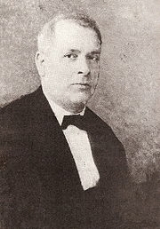
Nikol Galanderian
Encyclopedia
Nicol Galanderian is a noted composer of Armenian music
and is especially known for vocal, choral and children's works whose primary source of inspiration is folk music and urban folksong.
) historical Armenia
to a shoemaker's family, Nicol Galanderian lost most of his family in the Turkish massacres of 1894-96. He, his mother Eva and a brother survived.
 In 1900 he began studies under the noted Armenian composer Komitas Vardapet
In 1900 he began studies under the noted Armenian composer Komitas Vardapet
at the Gevorgian Seminary. He studied with Komitas for two years becoming familiar with Armenian church music and the Armenian notational system. He studied the violin and guitar on his own and continued to explore music theory. In 1910 he accepted a teaching position in Tiflis Georgia and in 1911 began his composing career with his first composition based on a text of Avedik Issahakian Yerger ou verker, "Songs and Wounds". With the recognition of his work came an invitation to teach at the Hykazian School in Tehran
Iran
, where he lived and composed the rest of this life. In Tehran, he organized and conducted the "Goghtan" choir, an Armenian choir that performed many of his works.
In 1913 he wrote a children's opera and, beginning in 1924, many other compositions for children. Many of his works draw upon Armenian poetry and writings. His works draw upon the poetry of Vahan Terian, Hovhannes Toumanian, Avetik Issahakian and others. His work includes the operas Parvana (a lake in Georgia), Hovik ("Breeze") and Lalvari vors ("Lalvar's Prey"). His compositions and manuscripts are in the archives of the State Museum of Art and Literature in Yerevan
Armenia.
He continued his compositional career until his death on 2 March 1944.
Music of Armenia
Armenia is situated close to the Caucasus Mountains, and its music is a mix of indigenous folk music, perhaps best-represented by Djivan Gasparyan's well-known duduk music, as well as light pop, and extensive Christian music, due to Armenia's status as the oldest Christian nation in the...
and is especially known for vocal, choral and children's works whose primary source of inspiration is folk music and urban folksong.
Biography
Born 7 September 1881 in Akn (AğınAgin
Ağın is a town and district of Elâzığ Province of Turkey. The mayor is Mustafa Yentür . The population of the town is 1844 as of 2010.- History :...
) historical Armenia
Armenia
Armenia , officially the Republic of Armenia , is a landlocked mountainous country in the Caucasus region of Eurasia...
to a shoemaker's family, Nicol Galanderian lost most of his family in the Turkish massacres of 1894-96. He, his mother Eva and a brother survived.

Komitas Vardapet
In 1950s his manuscripts were also transferred from Paris to Yerevan.Badarak was first printed in 1933 in Paris and first recorded onto a digital media in 1988 in Yerevan. In collecting and publishing so many folk songs, he saved the cultural heritage of Western Armenia that otherwise would have...
at the Gevorgian Seminary. He studied with Komitas for two years becoming familiar with Armenian church music and the Armenian notational system. He studied the violin and guitar on his own and continued to explore music theory. In 1910 he accepted a teaching position in Tiflis Georgia and in 1911 began his composing career with his first composition based on a text of Avedik Issahakian Yerger ou verker, "Songs and Wounds". With the recognition of his work came an invitation to teach at the Hykazian School in Tehran
Tehran
Tehran , sometimes spelled Teheran, is the capital of Iran and Tehran Province. With an estimated population of 8,429,807; it is also Iran's largest urban area and city, one of the largest cities in Western Asia, and is the world's 19th largest city.In the 20th century, Tehran was subject to...
Iran
Iran
Iran , officially the Islamic Republic of Iran , is a country in Southern and Western Asia. The name "Iran" has been in use natively since the Sassanian era and came into use internationally in 1935, before which the country was known to the Western world as Persia...
, where he lived and composed the rest of this life. In Tehran, he organized and conducted the "Goghtan" choir, an Armenian choir that performed many of his works.
In 1913 he wrote a children's opera and, beginning in 1924, many other compositions for children. Many of his works draw upon Armenian poetry and writings. His works draw upon the poetry of Vahan Terian, Hovhannes Toumanian, Avetik Issahakian and others. His work includes the operas Parvana (a lake in Georgia), Hovik ("Breeze") and Lalvari vors ("Lalvar's Prey"). His compositions and manuscripts are in the archives of the State Museum of Art and Literature in Yerevan
Yerevan
Yerevan is the capital and largest city of Armenia and one of the world's oldest continuously-inhabited cities. Situated along the Hrazdan River, Yerevan is the administrative, cultural, and industrial center of the country...
Armenia.
He continued his compositional career until his death on 2 March 1944.

